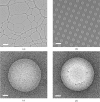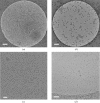Approaches to altering particle distributions in cryo-electron microscopy sample preparation
- PMID: 29872006
- PMCID: PMC6096488
- DOI: 10.1107/S2059798318006496
Approaches to altering particle distributions in cryo-electron microscopy sample preparation
Abstract
Cryo-electron microscopy (cryo-EM) can now be used to determine high-resolution structural information on a diverse range of biological specimens. Recent advances have been driven primarily by developments in microscopes and detectors, and through advances in image-processing software. However, for many single-particle cryo-EM projects, major bottlenecks currently remain at the sample-preparation stage; obtaining cryo-EM grids of sufficient quality for high-resolution single-particle analysis can require the careful optimization of many variables. Common hurdles to overcome include problems associated with the sample itself (buffer components, labile complexes), sample distribution (obtaining the correct concentration, affinity for the support film), preferred orientation, and poor reproducibility of the grid-making process within and between batches. This review outlines a number of methodologies used within the electron-microscopy community to address these challenges, providing a range of approaches which may aid in obtaining optimal grids for high-resolution data collection.
Keywords: cryo-electron microscopy; single-particle analysis; single-particle sample preparation.
open access.
Figures






References
-
- Arnold, S. A., Albiez, S., Bieri, A., Syntychaki, A., Adaixo, R., McLeod, R. A., Goldie, K. N., Stahlberg, H. & Braun, T. (2017). J. Struct. Biol. 197, 220–226. - PubMed
-
- Arteni, A. A., Ajlani, G. & Boekema, E. J. (2009). Biochim. Biophys. Acta, 1787, 272–279. - PubMed
-
- Baggen, J. et al. (2018). Proc. Natl Acad. Sci. USA, 115, 397–402. - PubMed
Publication types
MeSH terms
Substances
Grants and funding
LinkOut - more resources
Full Text Sources
Other Literature Sources

